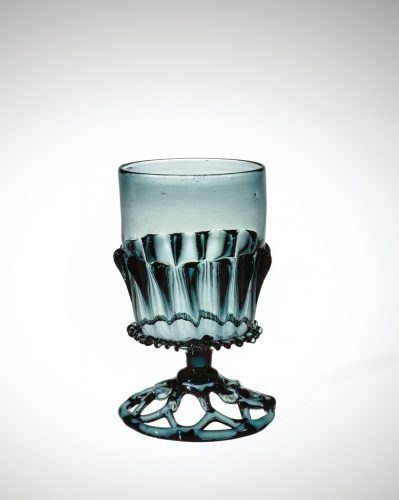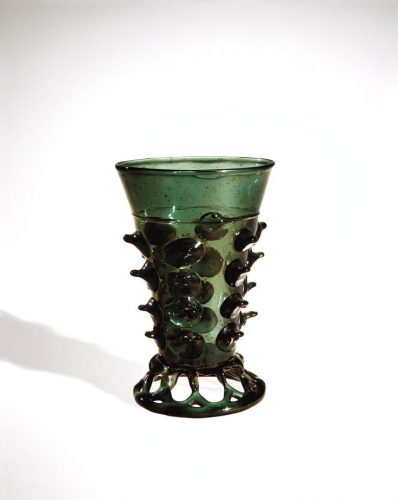 The term “Bohemian glass” is one that frequently leads to confusion for those just entering the world of art glass collecting; the word “Bohemian” is, after all, most strongly associated today with the romantic 19th century French movement that championed embracing a state of artistic poverty. Yet, upon delving into the realm of Victorian glassware, one finds it being used interchangeably with the term “Czech art glass”, rather than being synonymous with fin de siècle French glass.
The term “Bohemian glass” is one that frequently leads to confusion for those just entering the world of art glass collecting; the word “Bohemian” is, after all, most strongly associated today with the romantic 19th century French movement that championed embracing a state of artistic poverty. Yet, upon delving into the realm of Victorian glassware, one finds it being used interchangeably with the term “Czech art glass”, rather than being synonymous with fin de siècle French glass.
This is because the true history of Bohemian art—and art glass—lies much farther back than the late 1800s in Paris; its reach extends back millennia, into the wild, misty mountains of the Czech Republic.
Bohemian Glass Part One: From Ancient Origins to the Renaissance
When the French coined the term “Bohemians”, it was a rather derogatory phrase directed at the Roma people, whom the French mistakenly believed to be of Central European origin—namely, from the ancient Kingdom of Bohemia. Bohemia was a historical country which occupied approximately the same area the Czech Republic occupies today and which, along with Moravia and Silesia, formed what was known as the “Czech lands”.
Glassmaking and this region seem to have been tied together since time immemorial; historical findings have shown that the processing of glass in the Czech lands easily dates back to the time of the Celts; about two thousand years ago. By the 8-10th centuries, glass was being produced for largely ornamental reasons, most notably for costume jewellery.
Over time, the art of glassmaking spread across Europe, and slowly, the production of glass (along with other arts and crafts) ceased to be largely the work of monasteries. Many glassworks built around this time (eleventh-twelfth centuries) were built in forests, as workers needed a substantial quantity of wood to fuel their ever-hungry furnaces.
These early Bohemian glassworks produced what has therefore become known as “forest glass”, both in honour of where it was made and due to the green shade caused in the glass by the imperfect refining of the raw materials the glassworkers had at their disposal: potash and quartz sand. Potash, which was derived from the ashes of burned wood, was typically used as a melting material instead of soda, and “potash glass” was endemic to the old forests of Central Europe.
 By the thirteenth and fourteenth centuries, this rudimentary system of production had evolved into something more industrial, and the first true glass factories began to appear in the region of Bohemia and surrounding areas—notably in Ore, Jizera, the Lusatian Mountains, Giant Mountains, Forest Mountains and Moravia. By the middle of the 14th century, Czech glassmakers had mastered the creation of goblets, cups, and elaborate church and castle windows (later enriched by paintings). Czech glass tableware of this era was characterised by slender flutes and bulbous cups, many of which were decorated by glass spiral threads and pearl shapes (melted on during production). Such techniques were thought to have originated in Asia, and were brought to Europe during the crusades, whereupon the Czech glassmakers built on them, adapting them to create an authentically Bohemian style.
By the thirteenth and fourteenth centuries, this rudimentary system of production had evolved into something more industrial, and the first true glass factories began to appear in the region of Bohemia and surrounding areas—notably in Ore, Jizera, the Lusatian Mountains, Giant Mountains, Forest Mountains and Moravia. By the middle of the 14th century, Czech glassmakers had mastered the creation of goblets, cups, and elaborate church and castle windows (later enriched by paintings). Czech glass tableware of this era was characterised by slender flutes and bulbous cups, many of which were decorated by glass spiral threads and pearl shapes (melted on during production). Such techniques were thought to have originated in Asia, and were brought to Europe during the crusades, whereupon the Czech glassmakers built on them, adapting them to create an authentically Bohemian style.
According to glass historians, by the 16th century, there were at least 34 registered glass factories producing glass in Bohemia, the oldest of which is said to still be in operation today. These factories continued to innovate into the Renaissance, whereupon Czech glass artists began to emulate the then highly sought after Venetian-style enamel painting (doubly loved for the way it disguised small flaws, meaning that glassmakers could make good use of even second-rate glass). Once again, these master craftsmen made an imported technique their own, creating a more robust style of decoration, in direct contrast to the fine and delicate Venetian style. Coat of arms motifs, imposing depictions of rulers, and scenes from everyday life commonly appeared in the painted enamel works of 16th century Bohemia.
Bohemian glassmakers also discovered that potash, when combined with chalk, created a clear colourless glass—a form of glass even more stable than that which was being made in Italy at the time. For the first time in history, the term “Bohemian Crystal” emerged; soon becoming a sought-after commodity throughout Europe.
Then, as the 16th century gave way to the 17th, Bohemian glassmaking received its greatest boost to date: Emperor Rudolf II, ruler of the Holy Roman Empire, decided to settle in Prague. Rudolf was an avowed intellectual, and a generous patron of both the arts and the sciences; as such, he brought with him to Prague many of the finest artists and alchemists of his day.
Notable among these was a former diamond cutter by the name of Casper Lehmann; Lehmann had the brilliant idea of adapting copper and bronze gem cutting wheels to engrave glass, creating goblets and other fine glassware with rich, clean, detailed engravings. While Czech glassmaking was to take a brief hit as the 30 Years’ War raged throughout the region, this revolutionary technique would endure, later coming to define Czech glass art during the Baroque period.
